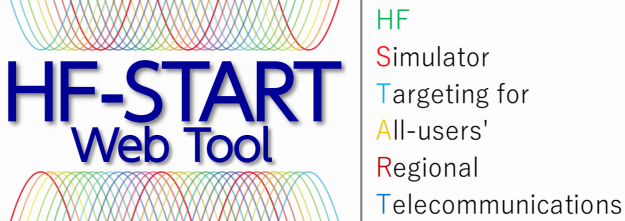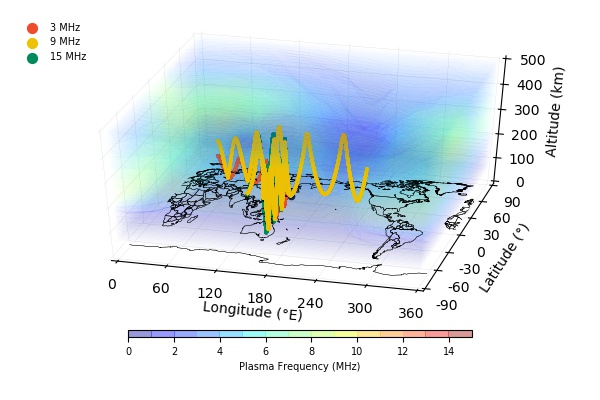Many thanks to SWLing Post contributor, Tracy Wood, who shares the following journal abstract from EurekaAlert.com:
Commencement of shortwave propagation simulator (HF-START) service
Demonstrating radio wave propagation paths between any two points based on real-time space weather information
NATIONAL INSTITUTE OF INFORMATION AND COMMUNICATIONS TECHNOLOGY (NICT)
[Abstract]
The National Institute of Information and Communications Technology (NICT, President: TOKUDA Hideyuki, Ph.D.), in collaboration with Electronic Navigation Research Institute, National Institute of Maritime, Port and Aviation Technology (ENRI, Director General: FUKUDA Yutaka) and Chiba University (President: TOKUHISA Takeshi), has started the service of shortwave propagation simulator (HF-START). It provides real-time shortwave propagation that reflects real space weather information from ground-based observations and model calculations. The HF-START web system has been successfully developed and is now available at https://hfstart.nict.go.jp/.
The web calculation function of this system allows shortwave propagation between any two points in Japan based on real-time GNSS observations and between any two points on the Earth based on model-based space weather information. Real-time estimation is possible. The calculation in the past and up to about 1 day ahead in the future is also possible. In addition to amateur radio, HF-START is expected to benefit efficient frequency operation of aviation communications that relies on shortwave in the polar route.
[Background]
Communication and positioning technologies play an important role in social infrastructure in various fields today. The ionosphere has regular temporal cycles and fluctuates greatly every day associated with solar activity and space environment. Of benefit to us is the fact that ionosphere is good at refracting shortwave, which is why we can hop shortwave signals off the ionosphere to communicate with people over large distances.
Shortwave band has been used for communication and broadcasting for a long time, and are still widely used in radio broadcasting, aviation communication, amateur radio, etc. Ionospheric variation, however, has a great influence on the propagation of radio waves. Communication environment such as the communication range and usable frequency changes significantly due to the influence of the ionospheric fluctuation. Thus, fluctuations in the ionosphere affect the operation of shortwave broadcasting, aviation communications, and amateur radio.
There have been websites that provide estimated information on how radio wave propagation changes due to such ionospheric fluctuations. The problem is that it is based on a simple model and does not reflect realistic ionospheric fluctuations.
[Achievements]
We have developed a shortwave propagation simulator HF-START that estimates and provides shortwave propagation information in real-time under realistic ionospheric fluctuations based on ground-based observations and model calculations. We open real-time information estimated by HF-START, and the web application at https://hfstart.nict.go.jp/.
Figure 1 shows an example of visualization of shortwave propagation by HF-START. In this system, the user can check the radio wave propagation information that is updated in real-time. As shown in Figure 2, the user can also use the web application to estimate and visualize radio wave propagation by specifying any frequency in the range of 3-30 MHz, any two points on the Earth, and any transmission angle. The date and time can be set retroactively to the past (after 2016), to the real-time, and in the future (up to about 1 day ahead).
The system can be used to visualize the radio propagation path and clarify whether it is affected by space weather when the shortwave you are using does not reach the destination, or when you can listen shortwave broadcasted from the far source that normally you cannot hear. Furthermore, in addition to amateur radio, it is expected to benefit efficient frequency operation of the aircrafts that use shortwave in polar route.
[Future Prospects]
We are conducting research and development to extend the HF-START to estimate radio wave propagation not only in the shortwave band but also in other frequency bands. In addition, we will evaluate the simulator accuracy and improve it by comparing it with radio wave propagation observations.
NICT has been providing information related to communications, satellite positioning, and radiation exposure since November 2019 as a member of the Global Space Weather Center of the International Civil Aviation Organization (ICAO). With the HF-START service, we expect to improve the information provided to directly relate to communications, such as communication range information.
###
As the abstract mentions, you can use the tool online now via the HF-Start Web Tool.
Thanks so much for the tip, Tracy. This is fascinating!



I tried this website, and it works only for Japan…
The README for using the tool is here: https://hfstart.nict.go.jp/readme_e.html
“GNSS” is a generic term for global navagational satellite systems – GPS, GLONASS, etc.